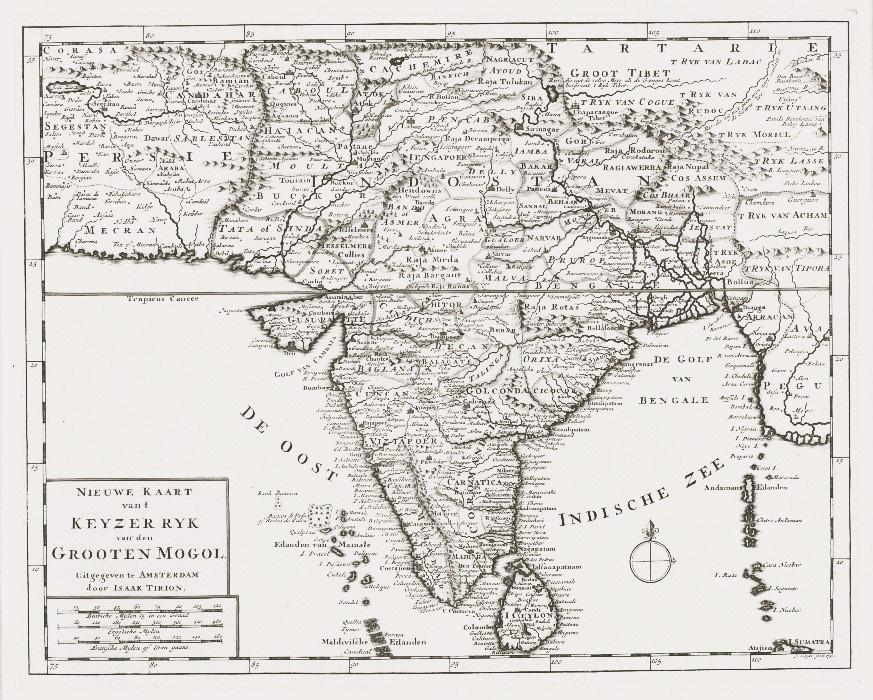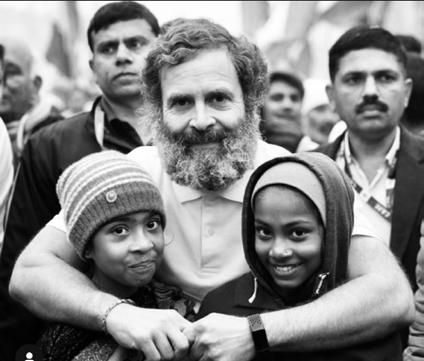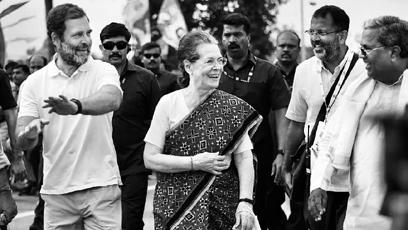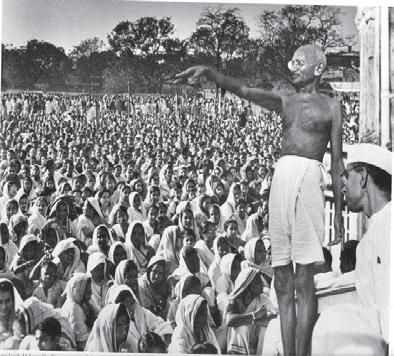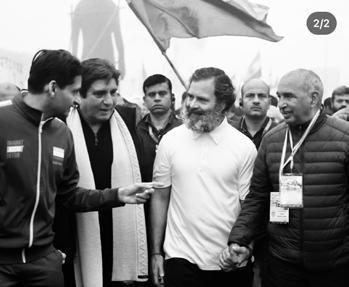HTS2 Term 2, 2023
Tutor- Matilde
Cassani
"The Changing Face of Yatra: Modern Challenges and Opportunities for Social and Political Mobilization"
"The essence of yatra is in the journey itself, not in the destination."
WHAT IS A YATRA ?

The word "Yatra" has its origins in Sanskrit, which is an ancient language of India. In Sanskrit, the word "yatra" (यात्रा) means "a journey" or "a pilgrimage." The word Yatra is associated with Hinduism, which refers to a spiritual journey or pilgrimage to a holy place. The concept of Yatra dates back to ancient times when sages and holy men would undertake long journeys on foot to visit sacred places.1 In the context of politics, the word "Yatra" is often used to refer to a political campaign or tour undertaken by a political leader or party. The objective of a Yatra in politics is to connect with people, understand their problems, and showcase the political leader's or party's vision and agenda. Political Yatras have a long history in India, and they are considered an effective tool to
mobilize public support, particularly in rural areas where people have limited access to media and communication channels.2 During a political Yatra, the political leader or party members usually travel to different parts of a state or region, addressing public gatherings, interacting with local leaders, and meeting with ordinary people. Political Yatras have been used by political parties of all ideologies in India, and they have been particularly effective in mobilizing support for regional or state-level parties. One such Yatra is the Bharat Jodo Yatra, which aimed to unite people from all walks of life and promote the idea of a united India. At the heart of the Bharat Jodo Yatra is the idea of inclusivity. However, the effectiveness of a Yatra in terms of electoral success depends on various factors, including the leader's or party's popularity, the timing of the Yatra, and the prevailing political climate. A yatra is also an act of journeying to the sacred landscapes following various types of paths like circular, linear, spiral, converging at a
central point, etc. For instance, A yatra starting and ending at the same point follows circular path.3
This essay will discuss the key relation of politics with architecture in context of political processions or ‘Yatra’. It will discuss the effect of yatra on surrounding environments, people and landscape and how that effects the interpretation and types of people joining the yatra. What role does Colour and Clothing play in organistation of a yatra? Does industrialisation in urban cities affect the movement of a yatra? But today when there is social media and online campaigns, is it really necessary to host a physical yatra? If yes, How does shifting landscapes affect a yatra? These are some questions this essay aims to answer by discussing the cause and affects of Bharat Jodo Yatra held 2 months ago as a part of political campaign from opposition party Indian National Congress.
Figure 1. Satyagraha movement 1930 by Mahatma Gandhi - Mahatma GandhiHISTORY OF YATRA
Mahatma Gandhi, a prominent leader of the Indian independence movement, did indeed spend a significant period of time in South Africa and later studied in London. When Gandhi returned to India in 1915, he adopted a unique approach to mobilize the masses and challenge British colonial rule. One of his most notable strategies was the symbolism of wearing minimal clothing, particularly a simple loincloth called a dhoti. This deliberate choice of attire aimed to connect with the impoverished masses and represent their struggles.4 By adopting the attire of the poor and dispossessed, Gandhi wanted to highlight the social and economic injustices faced by the majority of Indians. He believed that by embodying simplicity and renouncing materialism, he could inspire others to join the fight for independence and challenge British authority. Gandhi's clothing symbolized his identification with the marginalized and his commitment to their cause.
In 1917, Mahatma Gandhi launched a movement against the exploitative practices of British landlords in Champaran district, where indigo peasants were forced to grow indigo instead of food crops, and were often subjected to inhumane treatment. Gandhi’s movement was based on the principles of non-violence, civil disobedience and was successful in getting the British government to introduce new laws to protect the rights of peasants. The Champaran Satyagraha is considered a significant event in India’s struggle for independence and helped Gandhi emerge as a leader in the Indian independence movement. 5 Mahatma Gandhi also undertook several other Yatras during India's independence movement to mobilize public support for the sake of freedom from British colonial rule. One of the most famous Yatras undertaken by Gandhi was the Dandi March, also known as the Salt Satyagraha.6

The Dandi March Yatra was a 24-day journey undertaken by Mahatma Gandhi and his followers in 1930. The objective of the Yatra was to protest against the British monopoly on salt production, which made salt expensive and inaccessible to the common people.7

jarat and covered a distance of 390 kilometres, culminating in the coastal town of Dandi. Along the way, Gandhi addressed public gatherings, interacted with local leaders, and encouraged people to join the Satyagraha movement. On April 6, 1930, Gandhi and his followers reached Dandi and defied the British salt laws by producing salt from seawater. This symbolic act of civil disobedience sparked a nationwide movement, with people across India participating in the Satyagraha and boycotting British goods.8 The Dandi March Yatra was a turning point in India's independence movement and demonstrated the power of nonviolent resistance in achieving political objectives. The Yatra has since become an iconic symbol of India's struggle for freedom and a testament to Gandhi's leadership and vision. The Satyagraha movement led by Mahatma Gandhi was a carefully planned and orchestrated campaign of nonviolent resistance. The planning involved in the Satyagraha movement was critical to its success, as it allowed the movement to mobilize large numbers of people and effectively communicating its message. 9 Clothing played a significant role in the Satyagraha movement led by Mahatma Gandhi. The use of white clothing was a symbol of peace, serving to unite and mobilize participants in harmony.
“Many great people have gone on a yatra, most famous one was by the father of nation Mahatma Gandhi, but Vivekananda ji walked acrossed the country, my sikh friends here Guru nank ji walked across the country, Buddha walked across the country. There is a list of people who could use this idea of a yatra. I think the yatra is actually introspection, it is an attempt to understand whats going in the country, an attempt to listen to the people and allow them to express their voice."
- Rahul GandhiPOLITICS OF COLOUR AND CLOTHING
1 Navlakha, Gautam. “State Cultivation of the Amarnath Yatra.” Economic and Political Weekly 43, no. 30 (2008): 17
2 Ibid., 18
3 Christophe Jaffrelot, ‘The politics of processions and Hindu–Muslim riots’, In A. Basu and A. Kohli (eds.), Community Conflict and the State in India. Delhi: Oxford University Press, 1998. 61.
The Dandi March Yatra started from Sabarmati Ashram in Gu-
Colour and clothing are important aspects of a yatra politics that can impact the flow of circulation. Different colors and styles of clothing can convey different messages and signify different affiliations, which can affect the dynamics of a Yatra. In a Yatra, the flow of circulation is crucial for ensuring that participants can move efficiently and effectively towards their
4. Balakrishnan S., “What Made Gandhiji Wear Only Loincloth or Dhoti.”, Press Information Bureau, Government of India, 2016.
5. Fleiss, Alex. 2023. “How Did Gandhi Fight against British Rule?” Rebellion Research. February 21, 2023
6. Stanley Wolpert, Gandhi’s Passion. Oxford University Press, 2002. pg-91
7 Ibid., 92
8 Ibid.,93
9 Ibid.,111
10 Gandhi, Rahul “Indians Abroad Are Shining Examples of Our Culture of Respect | Interaction with Diaspora in London.” Youtube video, 2023. 3:30.
Figure 2. Quit India Movement 1942, India.destination. Mahatma Gandhi in his Satyagraha movement promoted white clothing to promote the idea of peace, therefore it created a sense of unity for everyone participating in the yatra. This identification through clothing fosters a sense of camaraderie and solidarity among participants, strengthening their collective resolve and shared purpose. In some instances, specific clothing choices can be used to challenge or subvert existing power structures or dominant ideologies. For example, during protest yatras, participants may deliberately adopt unconventional clothing styles or wear attire associated with marginalized groups to challenge societal norms and advocate for social justice. impact of color and clothing on a yatra's circulation extends beyond the participants themselves. Spectators, media personnel, and observers often interpret the symbolism conveyed by these visual cues, influencing their perception of the yatra and the message it seeks to convey. The interplay between color, clothing, and the overall atmosphere of a yatra can create a powerful visual narrative, shaping public opinion and mobilizing support for the cause at hand.
Today, various poltical parties use colour as a symbol to promote certain ideas and beleifs. For instance, members of Indian National Congress ( INC ) as depicted in Fig 4, follows the footsteps of Mahatma Gandhi and promotes white clothing along with white caps symbolsing peace. However the current ruling party BJP ( Bhartiye Janata Party ) as depicted in Fig. 5 promotes saffron clothing accesories, saffron is considered a sacred colour in Hinduism as it signifies fire which promises the idea of purity. On the other hand, members of Samajwadi party ( main opposition in state of Uttar Pradesh ) as depicted in Fig. 6 promotes wearing red caps symbolising the idea of change. However, the color and clothing can also affect this flow of yatra in a number of ways. For example, if participants are wearing clothing that is associated with a particular political party or movement, this may influence the behavior of others and create tension or conflict. Additionally, if different groups or factions within a Yatra are wearing different colors or styles of clothing, this may create divisions or impede the flow of circulation. It is also worthy noticing the importance of commute in a
yatra. Each of these poltical parties promotes usage of different vehicles. For instance, Congress led Bharat Jodo Yatra was entirely by foot. On the other hand BJP beleives in using cars to cover greater span of area. However, As depicted in Fig 6, Samajwadi Party promotes using bicycles in their yatra symbolising the life of an ordinary man. These aspects of colour, clothing, artefacts and means of travel signify the ideologies of a yatra, by changing certain aspects yatra can be interpretted entirely different.

TODAY'S YATRA

The Yatra in 1920s was very different from the Yatra of today. Similar to Satyagraha movement by Mahatma Gandhi, today Indian National Congress has introduced a nationwide yatra called 'The Bharat Jodo Yatra' which represents a unique intersection between politics, spirituality, and architecture. It started in September 2022 from Kanyakumari ( the southermost point in India ) and ended in January 2023 in Kashmir ( the northernmost point of India ). It seeks to unite people and promote the ideals of inclusivity and nonviolent resistance, which have been central to Indian political and social movements throughout history. The Bharat Jodo Yatra seeks to address pressing issues affecting the country like unemployment, price -rise, inequality and racial discrimination etc.
Gandhi's practice of walking long distances during Satyagraha movement has influenced Bharat Jodo Yatra. But today, It is also important to note the relevance of spatial experience for people joining the yatra. Participants joining not only wants to feel secure and protected but also want to feel motivated to walk long distances. While the essence of walking together for a common cause remains, the modern-day Bharat Jodo Yatra has embraced the use of temporary architecture to address the practical needs of organizers and protestors during their extensive journeys. In recognition of the need for shelter and accommodation for the large number of individuals participating in the yatra, they decided to use shipping containers on trucks ( Fig. 7 ) serving as temporary housing and an effective solution to create mobile
 Figure 4. Congress workers wearing white cap symbolising peace.
Figure 5. BJP workers wearing saffron coloured scarf symbolising hindu unity.
Figure 4. Congress workers wearing white cap symbolising peace.
Figure 5. BJP workers wearing saffron coloured scarf symbolising hindu unity.
hundreds of people embarking on the yatra. These containers can easily be transported and also makes sure that participants have a safe and comfortable place to rest. It also symbolizes the adaptability and resourcefulness of the yatra. Just as the yatra itself represents a collective movement for unity and progress, the repurposed containers embody the ethos of making the most out of available resources to meet the needs of the participants.

opment has dramatically transformed the organisation of a yatra, presenting new challenges and obstacles. With the growth of cities and the expansion of highways and other transportation networks, Yatras today often face more obstacles and challenges than they did in the past. For example, traffic congestion and urban settlements can slow down the progress of a Yatra, making it more difficult to reach its destination.
ly impactful means of social engagement.
"When I began walking from Kanyakumari, I asked myself about my responsibility. Now, as I walk to worship and discover my nation, I am one of thousands of people on this journey. In this situation, what is my responsibility? After some thought, an idea struck me. I gathered my companions and shared a proposal that the 20-25 feet of area on all four sides of us, this would be our home for the next four months. This home will move with us from 6 am to 7 pm every day. Everyone who joins us in this house, whether rich or poor, old or young, from any religion or state, or even foreigners or other species, should feel like they have come home."11
- Rahul Gandhi ( translated to english )
The incorporation of temporary architecture, specifically shipping containers, within the Bharat Jodo Yatra represents a fusion of tradition and innovation. While honoring Gandhi's spirit of collective action and long-distance journeys, the practical adaptation to temporary housing showcases the evolving nature of yatra. By blending the age-old concept of walking together with innovative solutions, the yatra continues to be a powerful means of mobilization and advocacy in contemporary India.
Due to significant changes in the landscape, the flow of movement during a Yatra has been heavily impacted. Today, Yatras often involve traversing through highly congested highways, bustling traffic, densely populated urban settlements, commercial zones, and various other obstacles that did not exist during the Satyagraha movement. The rapid pace of urbanization and infrastructure devel-

Despite these challenges, Yatras today still serve an important purpose in bringing people together and promoting awareness of important social issues. While the landscape may have changed, the fundamental principles of the Yatra remain the same. Yatras are still a powerful tool for social and political mobilization, and they continue to play a significant role in Indian society.
CONCLUSION
In conclusion, while the Yatras of the 1920s and the Yatras of today differ due to changes in the landscape, the fundamental principles and significance of Yatras have endured. Despite the modern challenges and obstacles, Yatras remain a powerful tool for promoting social awareness and mobilization. The yatra of today holds physical importance as well as psychological importance, a person leaving their home to join the yatra wants to have a safe environment while walking in the yatra. They also value the company of like-minded individuals, as it helps foster unity and minimizes conflicts along the journey. Consequently, participants expect efficient organization, including managing traffic on the streets, maintaining accounts of the people who join the Yatra, and facilitating a conducive learning experience while walking. While the rise of social media as a campaigning tool is a progressive development, it does not diminish the importance of Yatras. The physical presence and collective energy generated during a Yatra cannot be replicated solely through virtual platforms. Yatras provide a unique experience that combines personal commitment, communal solidarity, and the immersion in real-world surroundings, making them a deep-
Therefore, despite the changes brought about by the evolving landscape and technological advancements, Yatras retain their timeless significance. They continue to evoke a sense of purpose, unity, and social consciousness among participants, fostering connections and promoting change. The essence of Yatras, rooted in their historical and cultural importance of India, remains relevant in contemporary society, demonstrating the enduring power of this age-old tradition in shaping social movements and influencing collective action.
Figure 8. Bharat Jodo Yatra in Kashmir, 27 January 2023.
